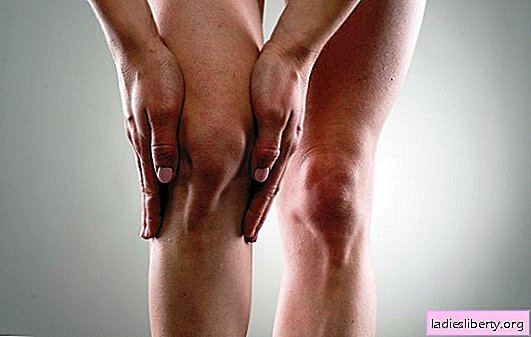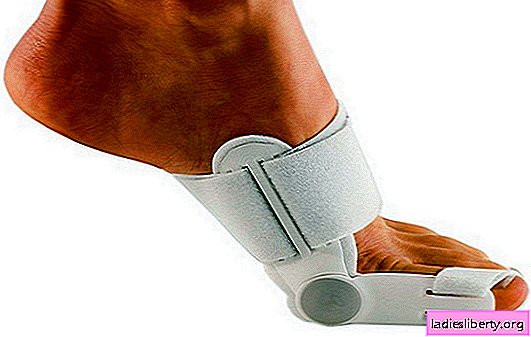
Inflammation of the knee joint - arthritis of the knee joint - is so common that one can probably say: each person at one time suffered a similar disease with one or another outcome.
There is inflammation of the knee joint at any age, depending on the causes that cause arthritis in each case.
Regardless of the clinical manifestations, the disease is always unpleasant: the usual rhythm of life is violated with a little discomfort in the knee joint and, especially, with severe pain and other symptoms.
Knee Inflammation - Causes
The main causes of knee inflammation include:
- injuries;
- mechanical overload (long kneeling - at the miners);
- infections;
- autoimmune processes with the formation of antibodies to the body’s own tissues (in particular, to cartilage of the joint);
- insect bites and in the future - an allergic reaction (Quincke's edema, urticaria);
- subcooling.
Depending on these causes, changes occur in the joint of the knee, which can manifest themselves with specific or general inflammatory symptoms:
1. Rheumatoid arthritis - bilateral process; occurs at any age, including in children; eventually leads to destruction of the knee cartilage.
2. Osteoarthritis - the most common disease, diagnosed mainly in middle-aged and elderly people; It affects the articular surfaces with thinning and degeneration of the cartilage, as a result of which the mobility of the joint is impaired, and subsequently inflammation of the knee joint with all its clinical symptoms joins.
3. Post-traumatic arthritis is the result of a trauma, both acute (strokes, falling onto a joint, car accident), and chronic (trauma-overload), which lead to damage to ligaments, meniscus, cracking. May develop for a long period after injury. The changes in the knee joint and symptoms are similar to osteoarthritis.
In addition to the above reasons, there are other factors that cause diseases of the knee joint.
Autoimmune processes with damage to the connective tissue, which are accompanied by inflammation of the knee joints:
- rheumatism;
- vasculitis (systemic lupus erythematosus);
- rheumatoid arthritis.
Diseases caused by infectious agents and manifested by arthritis of the knee joints:
- syphilis;
- gonorrhea;
- Reiter's disease;
- tuberculosis;
- coccidiomycosis.
Knee Joint Inflammation - Symptoms
Despite the variety of causes that cause inflammation of the knee joint, the symptoms of arthritis are similar, as in any inflammatory process:
- pain
- redness of the joint
- edema;
- changes in blood tests: in the general clinical - leukocytosis, increased ESR, eosinophilia in case of allergic reactions; in blood tests for rheumatic tests - positive C - reactive protein, rheumatoid factor, formol sample.
Depending on the severity of the disease, symptoms of intoxication may join: fever (including locally above the affected joint), headaches, general weakness, weakness, decreased appetite, and poor sleep. Over time, the joint is deformed, which leads to restriction of movements, with some diseases - to stiffness in the morning.
Inflammation of the knee joint is acute, subacute and chronic.
In the acute stage, the clinical picture is vivid, with severe symptoms inherent in inflammation: a rapid onset, accompanied by severe pain in the knee joint, redness of the joint, severe swelling, the joint is hot to the touch, there are signs of general intoxication.
In the chronic process, the symptoms of inflammation are erased, little expressed, intoxication is absent, the pains are variable, not as intense as in the acute course, the joints swell slightly, but with a long process they are deformed, limited movement, crackling during bending, seals, nodules can form in the joint area depending on the disease.
In the subacute stage, the symptoms of inflammation of the knee joint are not so pronounced as in the acute phase: there is an increase in temperature to low numbers, pain in the joints is less intense than in the acute course and are spontaneous, hyperemia, edema, and local temperature increase over the joint are moderate. Joint deformity may be observed.
Despite the fact that in most cases, if it is not a systemic, infectious or rheumatic disease, inflammation of the knee joint ends successfully, with untimely treatment and diagnosis, dangerous complications can arise:
- purulent inflammation of the tissues surrounding the joint - bursitis;
- sepsis;
- inflammation of bone tissue;
- subluxations and displacement of bones
- restriction of movements in the joint up to contracture ;;
- phlegmon and panarthritis.
Therefore, it is necessary to consult a doctor on time so that after a thorough diagnosis an accurate diagnosis is established and treatment is started in a timely manner.
Important role in the correct diagnosis, a carefully collected medical history is played, which makes it possible to determine the cause of the disease and prescribe adequate treatment.
A detailed clarification of complaints also helps determine the diagnosis and purpose of treatment.
Laboratory diagnostics, including, in addition to routine methods, determination of uric acid, antibodies to hemolytic streptococcus, specific tests to exclude venous diseases, tuberculosis.
X-ray examination of affected joints.
If necessary - ultrasound, MRI, CT of the joint.
In complex cases - arthroscopy, biopsy and puncture of the joint with the study of synovial fluid.
Knee inflammation - treatment
The tactics of treating inflammation of the knee joint is determined by the cause of the disease, the manifestation of which was arthritis. First of all, drugs are prescribed that eliminate the cause or causative agent of the disease: antibiotics, antifungal, antiviral, antiallergic drugs - in each case individually.
Physiotherapeutic and local treatment are widely used.
In addition, anti-inflammatory drugs from the NSAID group are used (Diclofenac, Nimesulide, Indomethacin, Meloxicam, Celebrex, Arkoksia, Vioks), corticosteroids (prednisone, etc.) and immunosuppressants (Methotrexate, Cyclophosphane, Azathioprine) are often used. In severe cases, intra-articular administration of glucocorticoids (Kenalog, Diprospan, Celeston, Floreston, Hydrocortisone), chondroprotectors (Goal-T, Chondrolone, Alflutop) and hyaluronic acid is carried out.
Glucocorticoid injections are used to eliminate the pain symptom and signs of inflammation. This is a symptomatic treatment, not an etiological one: glucocorticoids do not eliminate the cause of the disease, but only alleviate the condition.
Chondroprotectors are drugs for the etiological treatment of already damaged cartilage structure, they restore the progression of the disease, participating in the metabolic processes of cartilage.
Intra-articular hyaluronic acid administration is by far one of the most effective and innovative methods of treatment: these injections are called a “liquid prosthesis”. The effectiveness of hyaluronic acid is explained by the fact that sodium hyaluronate is an integral part of synovial fluid, which ensures mobility of a healthy joint. The introduction of hyaluronic acid restores the normal composition of the synovial fluid, eliminates the clinical manifestations of joint disease.
Local treatment with tinctures, ointments (Indomethacin ointment, Diclofenac, Dopgit-cream), gels (Dip - Rilif, Ketonal - gel, Diclofenac - gel), compresses with medicines (Dimexidum).
- During the treatment period, an important condition for successful treatment is to reduce the load on the diseased joint;
- weight control and weight loss (proper nutrition and adequate physical activity);
- regular exercises on the joints - a special complex of exercise therapy.
During treatment, bed rest is often necessary to reduce the load on the joint.
In the case of a far-reaching process and destruction of the articular tissue, one has to resort to surgical methods of treatment: -endoprosthesis of the joint,
- joint fusion surgery (if endoprosthetics are not possible).
Surgical methods are also used in cases where all methods of conservative treatment have been exhausted.
You need to understand: when pain occurs in the joint and other signs of malaise appear, it is urgent to consult a doctor to prevent further development of the disease and dangerous complications.











